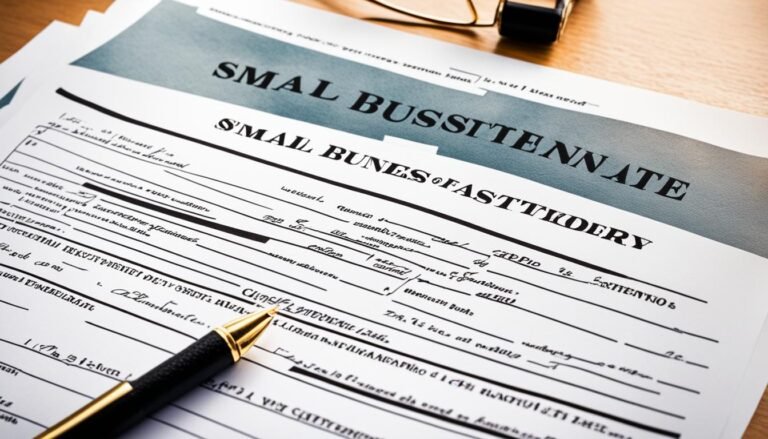Liquidation: A Guide for Small Business Owners
More than 600,000 small businesses close in the U.S. each year. They may face tough financial times or want a fresh start. This can lead to a process known as liquidation.
Liquidation means closing a business and selling its assets. It’s not easy, but small business owners can get through it. They just need the right knowledge and guidance.
Key Takeaways:
- Each year, over 600,000 small businesses in the United States close their doors.
- Liquidation is the process of closing down a business and selling its assets.
- Small business owners can navigate the liquidation process with the right knowledge and guidance.
- Understanding the different types of liquidation and the steps involved is crucial.
- Seeking professional assistance from a liquidation expert can help maximize asset value and ensure a smooth process.
What is Liquidation and Why does it Happen?
Liquidation means closing down a business for good. Its assets are divided among shareholders, creditors, and others. This can happen by choice or because the business is doing poorly or has too many debts. A specialist called an insolvency professional manages the whole closing down process.
Shutting down a business via liquidation is a big deal. It’s crucial for business owners to grasp this process. It could be due to money troubles, unmanageable operations, or just a choice to leave the market. An expert in insolvency helps in calmly ending the business and making sure all legal rules for dividing assets are met. This professional makes sure things are done fairly.
Assets during this time are sold. The money made pays the business debts. If anything is left after paying debts, shareholders get it. The insolvency pro makes sure assets are sold right. They figure out which debts to pay first. When everything is done, the business is no more.
Closing a business with liquidation is not easy. It involves many legal and money matters. Business owners should get advice from an insolvency pro to make everything go smoothly. Knowing how liquidation works and having a pro by your side means assets are shared out fairly and by the law.
“Liquidation is the final chapter of a business, and it’s crucial to approach it with a strategic mindset. The process involves a thorough assessment of the company’s financial situation, proper valuation of assets, and effective distribution to creditors. Seeking guidance from an insolvency professional can provide clarity and expertise in this challenging phase.”
Types of Liquidation
Businesses facing major troubles might go through liquidation. There are three main types they might encounter. These are creditors’ voluntary liquidation, compulsory liquidation, and members’ voluntary liquidation. Each type serves its own purpose and starts under different circumstances.
Creditors’ voluntary liquidation happens when a business owner knows they can’t clear their debts. Then, they opt to call a liquidator themselves. This choice lets the business owner lead the process. Together with the liquidator, they handle asset distribution and debt settling.
Compulsory liquidation happens when creditors push to close a business for unpaid debts. In this type, outside parties kick off the process, claiming the business can’t continue running. The court then steps in to pick a liquidator. This person makes sure assets are distributed fairly to creditors.
Members’ voluntary liquidation is when business owners agree to end their company. To choose this, at least 75% of company members must be on board. It’s a common route for businesses that have met their goals or are no longer making money.
The differences between the three types of liquidation can be summarized as follows:
| Types of Liquidation | Initiation | Control | Purpose |
|---|---|---|---|
| Creditors’ Voluntary Liquidation | Initiated by the business owner | Business owner works closely with the liquidator | To settle debts and distribute assets |
| Compulsory Liquidation | Initiated by creditors | Court-appointed liquidator | To repay creditors and distribute assets |
| Members’ Voluntary Liquidation | Initiated by business owners | At least 75% of members must agree | To voluntarily exit the company |
How Does the Liquidation Process Work?
The liquidation process is a way of shutting down a business. It’s about paying off debts and giving out what’s left fairly. Several steps are taken to make sure everything is done properly and in order.
1. Processing Paperwork
First, the business must get all its paperwork ready. This means telling government offices and other essential steps. It’s about meeting legal rules and getting things set before moving on.
2. Appointing an Insolvency Professional
A special professional, like a licensed liquidator, is chosen to handle everything. They’re skilled at dealing with the sale of assets, figuring out what’s owed, and paying creditors.
3. Dissolving the Assets
Next, the business sells all its stuff, like buildings, stock, and tools. The money goes to pay debts. This step helps clear up financial ties.
4. Determining Debts
The insolvency professional figures out how much the business owes. They sort out who gets paid first. This could mean money goes to secure debts, wages, or taxes ahead of others.
5. Distributing Funds to Creditors
After knowing all debts, the next job is to pay off creditors in order. This step makes sure everyone is treated fairly, as the law demands. Creditors receive money based on rules.
6. Business Closure
Once all assets are sold and debts paid, the business formally ends. This involves stopping all operations, closing accounts, and taking the business off the records.
Completing these steps leads to an organized and clear liquidation. It helps businesses wind down smoothly when they have to shut shop.
What Happens After Liquidation?
After liquidation, key events show the business is done. It marks the closure and end of its operations.
Business Dissolution
After liquidation ends, the business is formally dissolved. This means it’s permanently closed and its name taken off the registrar. Dissolution makes the end of the business official by law.
Company Closure
After liquidation and dissolution, the business stops. It doesn’t do any more commercial activities. All work, contracts, and projects stop completely.
Employee Termination
With the business closing, employees lose their jobs. Since the business won’t reopen, their contracts end. Giving them support and clear communication is vital during this difficult time.
Transfer of Rights
During liquidation, the business and its assets’ rights move to the insolvency professional. This person manages the liquidation. They make sure the assets are fairly shared among creditors and claimants, following the law.
“The transfer of rights is an essential step in the liquidation process, ensuring that the distribution of assets is conducted impartially and in compliance with the law.”
Asset Dispersal
All the business’s remaining assets are dealt with in liquidation. This means selling off assets, clearing debts, and sharing money with creditors. This process is overseen to make sure it’s fair for everyone.
Unlike bankruptcy, there’s no chance for the business to come back after liquidation. It marks the final end of the company’s story. Only the financial settlements and an empty operation space are left.
Tips to Avoid Liquidation
Many small business owners deal with big financial hurdles. These hurdles could risk their business closing. To stay clear of this and beat the challenges, they need proactive steps. They should focus on managing cash flow, cutting costs, and checking their finances. Knowing what debts to handle first is also key. Doing these things helps a business stay stable and grow.
Evaluate Your Finances
It’s vital to often check your money situation to spot issues early. Look at what you earn and spend, figure out future cash flow, and see where to cut costs. This step helps in making smart financial moves.
Implement Cost-Cutting Measures
Staying away from liquidation means making hard choices on spending. Find ways to spend less without harming what your business offers. It might mean talking to suppliers again, creating new marketing plans, or optimizing how you work. Cutting costs smartly makes your business financially stronger and less likely to close.
Prioritize Debts
When money gets tight, knowing which debts to pay first is important. Look at what you owe and see what needs urgent payment. Focusing on debts with high interest or that are late helps you use money better, avoid big problems, and keep creditors happy.
Communicate with Lenders and Suppliers
Being open with those you owe or buy from is key when facing money issues. If you see paying on time will be tough, talk to them early. They might help by changing payment terms or offering short-term help. This can keep the business afloat and avoid shutting down.
Explore Alternative Solutions
Thinking outside the box could save your business from closing. This might mean getting more cash through loans or finding business partners. New ideas and partnerships can bring in funds and resources, helping the business grow again.
By acting early and being creative, small business owners can avoid liquidation. This turns money problems into chances for the business to succeed.
What Does it Mean to Liquidate a Business?
Liquidating a business means turning assets into cash by selling them. This can happen voluntarily or because the business can’t pay its debts. The money from selling goes to pay debts. This is a way to end the business and handle its financial matters.
When a business is liquidated, it’s important to plan carefully. The aim is to get the most money from selling the assets. All the debts should be paid as much as possible. This means checking the value of the business’s things and selling them in a smart way.
The main part of liquidation is selling what the business owns. This can be things like stuff to sell, equipment, land, or ideas like patents. These items are sold in different ways, like at auctions or with the help of a business broker.
Businesses can face liquidation if they’re going broke and can’t pay their bills. This might happen if the business isn’t being run well, sales are dropping, debts are too high, or the economy is bad. So, liquidation can be a way to fix a big money problem and lose less money.
Sometimes, the business owner chooses to end the business. They might see there’s no more money in it or no way to get better. Or, the business might be forced to close if it can’t pay what it owes.
To close a business, a lot of careful financial and legal work is needed. It’s smart to get help from someone who knows how to do this. This makes the process easier and less stressful.
Benefits of Liquidating a Business
Shutting down a business can actually be good for the owners and others involved:
- It helps to pay off all debts in a fair way.
- It stops the owner from losing more money or getting deeper in debt.
- It gives a chance to start a new business without old problems.
- It lets the owner focus on work they do best.
| Key Points | Benefits of Liquidation |
|---|---|
| Clearing Debts | Ensures all debts are paid properly |
| Minimizing Losses | Stops more debt from building up |
| Opportunity for Fresh Start | Gives a new beginning to the owner |
| Focus on Core Competencies | Helps the owner work on what they do best |
Ending a business is a big decision. But with the right help and planning, owners can move through this and find success in the future.
Differences Between Liquidation and Dissolution
Understanding the differences between liquidation and dissolution is key when closing a business. Both terms mean the business is stopping, but how they end is different.
Liquidation:
Think of liquidation as a step in closing down the business. It means selling off what the company owns, like its stuff or property. Then, the money made is shared among those who have a part in the business. Even while doing this, the business still has things it must take care of.
Dissolution:
When a business dissolves, it’s saying goodbye officially. It’s the end of the company. After this, there’s no need for the business to keep up with laws and rules. The company then wraps up its last tasks and tells the necessary people it’s done.
It’s important to know the contrast between liquidation and dissolution. This knowledge helps when choosing what to do with a business that’s stopping. Depending on different factors, one choice might be better for following the law and rules.
Comparing Liquidation and Dissolution
| Liquidation | Dissolution |
|---|---|
| The business continues to exist | The business ceases to exist |
| Involves selling assets and distributing proceeds | Involves winding up affairs of the company |
| Ongoing obligations remain | All compliance obligations end |
To pick between liquidation and dissolution, think about the business’s current setup. By looking at what the business still needs to do legally, its owners can choose which option is the right one.
Using a Liquidation Professional
When you need to close down a business, hiring a liquidation professional is key. They help make the process smooth and successful. These experts know how to value your assets, settle your debts, and plan sales to get the most out of everything you’ve built.
Liquidation professionals offer valuable knowledge and experience. They make dealing with hard laws and procedures a lot easier. Their advice is essential for making the most out of your business’s final sale.
Evaluating your business’s assets is a big task for these pros. They are skilled at figuring out what everything is worth. This is crucial for getting a good deal when selling off your business’s parts.
They also help tailor a plan to sell your assets right. A liquidation professional will choose the best way to sell. They might suggest a regular sale or an auction to get more people interested and to get the best price.
Debt settlement is another area where they shine. These experts work with your creditors to come to an agreement on what you owe. This makes sure everyone is treated fairly and the process goes smoothly.
By hiring a liquidation professional, you’re making a smart move. Their skills in every part of the liquidation process improve your chances of a good outcome. From pricing assets to settling debts, they are there to get the job done right.
Benefits of Hiring a Liquidation Professional
“Hiring a liquidation professional can make closing your business much easier. They know how to evaluate your assets, settle your debts, and plan the sale to get the most money. With their help, you can handle the legal and financial parts of closing down better.” – John Mitchell, Small Business Consultant
Comparison of Liquidation Professional Options
| Criteria | Option A | Option B | Option C |
|---|---|---|---|
| Expertise | Specializes in liquidations | General financial expertise | Not applicable |
| Pricing | Competitive rates | Higher cost | Varies |
| Industry Experience | Extensive experience in your industry | Limited industry-specific knowledge | Depends on the professional |
| Client Testimonials | Positive client reviews | Mixed client feedback | No client testimonials |
Picking the right liquidation professional is a big deal. Look at what they know, how they charge, and what others say about them. A good professional can really boost how much you can get for your business.
Steps for Liquidating Business Assets
Liquidating business assets is a key part of closing down. It means selling items to get money back. This process has important steps to follow. Here is what you need to do:
Create an Asset Inventory
Start by making a list of everything you need to sell. This list should include items like machines, inventory, and even ideas like patents. Knowing what you have helps you set prices and find buyers easier.
Determine Price Reductions
After listing your assets, decide on the prices. Look at what similar things are selling for. Think about if your items need to be cheaper to sell faster. This helps get the money back quicker.
Develop a Promotion Program
Getting the word out is important. Make ads, post online, and use social media to show what you’re selling. This way, more people can see it and make an offer.
Consider Auctions or Work with a Business Broker
You can sell at an auction or use a broker to help. Auctions are good if many people want what you have. Brokers know the market well and can help you find good deals.
Select the Best Time for the Sale
Timing is key to making the most money. Look at when it’s best to sell based on what people are buying. This way, more buyers are likely to be interested, and you can get a better price.
Following these steps will help you close your business well. You’ll be able to sell all you need and make more money back.
Conclusion
Liquidating a small business can be tough, but with the right plan, it’s doable. You should look at your finances carefully and get advice from pros. This helps make a good plan that lessens the blow for everyone involved.
Telling the truth and talking openly during the process is key. It keeps trust strong and cuts down on bad outcomes. Talk clearly and honestly with those who are part of the business, like creditors and employees.
Choosing to close the business is a big decision. But before you do, look at other options too. Getting expert advice to explore different roads can be very smart. It might even help you find a way to start anew.







